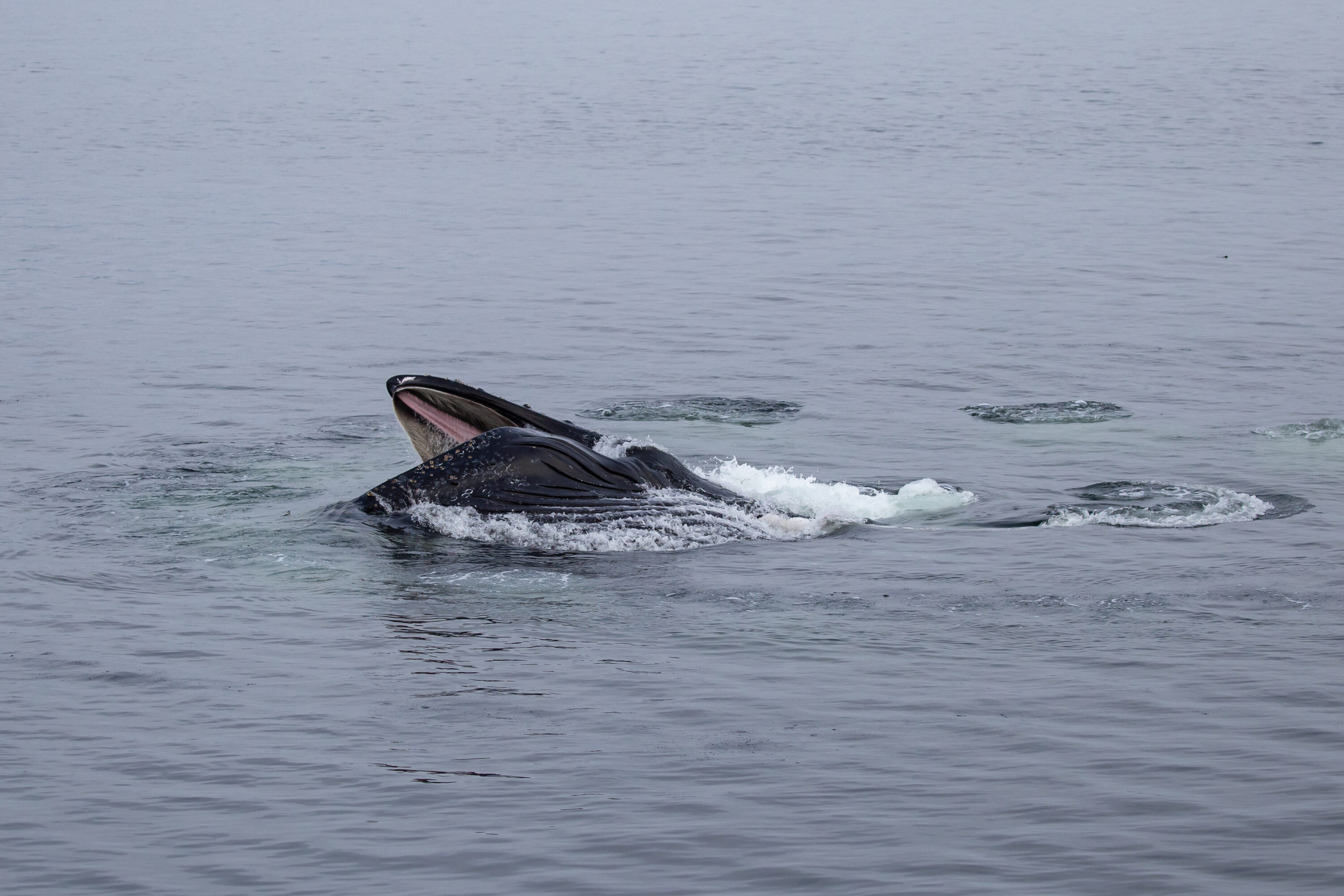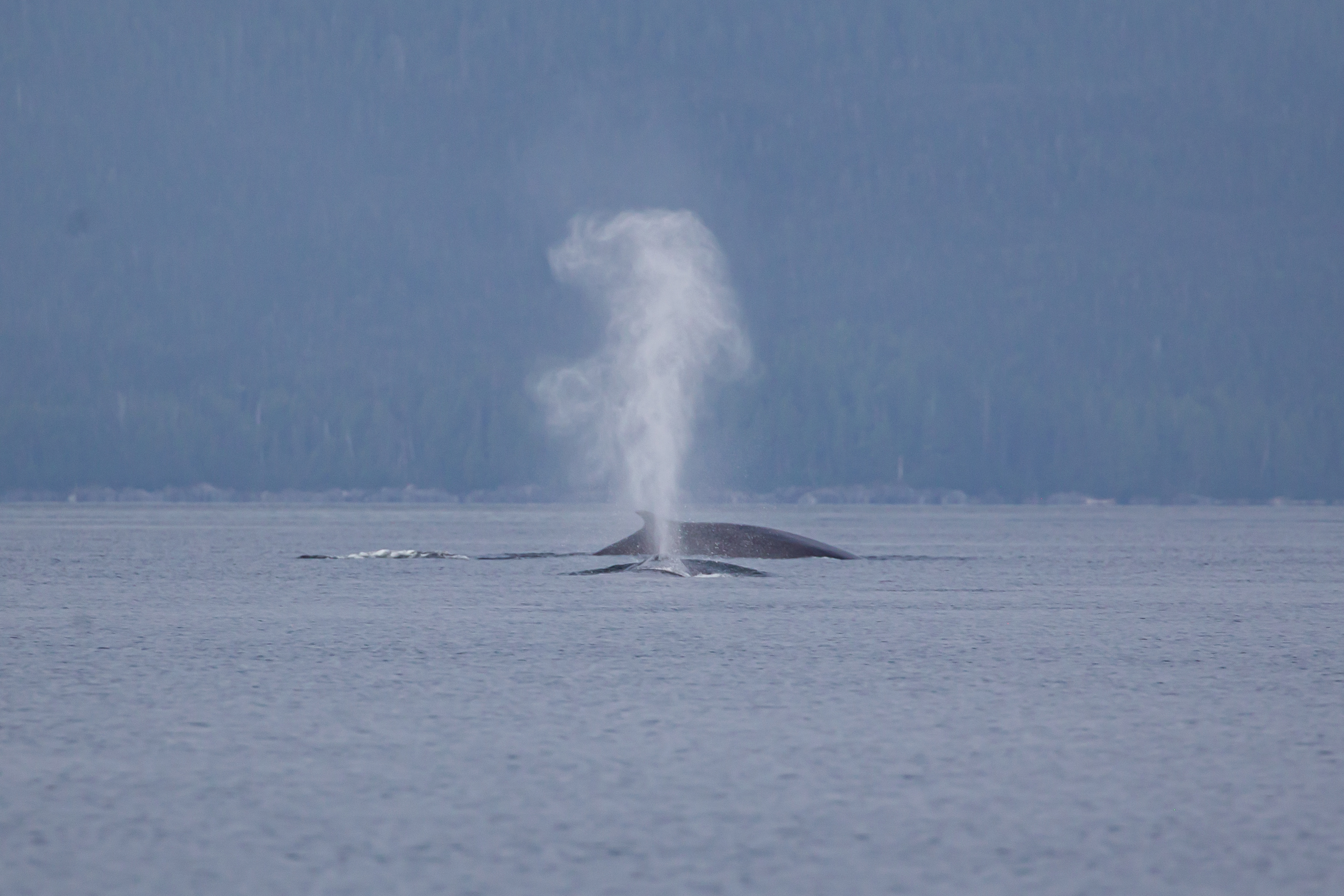A Changing Habitat
Early this morning, with the sun just beginning to crest over the tops of the trees and illuminating the glassy waters of Squally Channel, I sat in the canoe halfway between the Fin Island Research Station and the anchorage which keeps our boat, the Elemiah, protected from harsh weather. She sits in her small cove about a kilometre away from the station, waiting to venture out into the whale dense waters of BC’s north coast. The paddle brings curated moments of calm and reflection to the beginning and end of each day. But, as I floated along, being pushed onwards by the current, I was not calm. Repeatedly, my head whipped around, and my neck craned trying to find the source of the explosive breaths I was hearing behind me.
These waters are unexpectedly adept at concealing the location of whales. The sounds of their blow can travel across the channel seconds after they have already descended to the depths. Eventually, I began paddling again, having had no luck at locating the source of these deep exhales.

A fin Whale Blowing air. Photo © T he North Coast Cetacean Society
Our plan for the day was to take advantage of the calm weather window to systematically survey Otter Channel and Nepean Sound, waterways in Gitga’at Territory which border open ocean. We need a perfect forecast to safely complete these surveys, and today was our day. As I rounded the corner in the Elemiah to pick up Braede and Zoey at the station, I was stopped in my tracks as humpback whale BCX1498 was solo bubble net feeding back and forth along the shoreline right in front of the station. I couldn’t help but wonder if this was the whale whose breaths I was hearing while paddling, but I wasn’t convinced. This whale had come out of Lewis Passage, around the corner from our station and largely out of ear and eye shot.
As the bubble netter worked its way north, I was able to bring the boat in and get Zoey, Braede, and all our research gear on board. We set off in the direction of our survey… but didn’t make it far. Hannah called us on the radio, having just started the first land-based scan of the day. Immediately, she saw the telltale tall, cylindrical blows of fin whales a few kilometres south-east of where we were. In the few seconds it took me to reach the radio and begin talking, the words “we are going to take a detour” flew out of my mouth before my brain could catch up.

A humpback whale bubble-net Feeding. Photo © The North Coast Cetacean Society
As we slowly approached, we watched at a distance as one, two, three, and then four fin whales surfaced one after the other. This was the source of the powerful blows I had heard in the canoe!
To see fin whales in this region is incredible, as they were nearly lost to this coast in the days of commercial whaling. In the last two decades, we have documented their resurgence and reliance upon these inner fjordic waters of Gitga’at Territory. This is perhaps the only place in the world where fin whales can not only be seen, but also individually identified from land.

Two fin whales close to shore in Lewis Pass. Photo © The North Coast Cetacean Society
It quickly became clear that there were at least 10-12 fin whales clustered together in a small area, with 3 humpback whales interspersed throughout – sharing habitat peacefully. The fin whales alternated extended periods of rest at the surface with prolonged, deep dives into the water column. This behaviour is very common to see during the daytime, as they follow their prey to the depths. At night, the fins spend much more time close to the surface, as their prey migrates upwards in the water column.
To see so many together utterly took my breath away. The feeling of drifting alongside beings who can be more than 13 times my own length is difficult to describe. I feel the vibrations from the sound of their breath in my chest, and I’m constantly in awe of their ability to glide seamlessly through the water – seldom revealing their true size.
This year marks a great change to their safety in these waters. LNG super tankers have officially started transiting to and from Kitimat this summer, placing the whales who are still recovering in this region at risk of being struck and killed. Fin whales are one of the most vulnerable species to ship-strike, and this large group was directly on the tanker route for over an hour. Through good fortune, the tanker was currently docked and loading up with Liquid Natural Gas in Kitimat and did not come through at the time these fins were collectively using what is now an incredibly dangerous area. They do not know this has changed, at least not yet.

A liquid natural gas tanker with a tug. Photo © The North Coast Cetacean Society
This is a pivotal time for our research and our ability to speak for the whales whose voices are not recognised at human decision-making tables. With over 20 years of baseline knowledge and data, hydrophones in the water listening to the whales and monitoring the impacts of noise, and with the Fin Island Research Station overlooking one of the most whale dense areas along the tanker route, we will be able to document the changes that are occurring and use them to ensure whales can continue to return to these waters for generations to come.
Leaving the fin whales behind, we made it out into Nepean Sound to begin our transect survey of another area the LNG tankers navigate. Buzzing with motivation after seeing such an immense number of fin whales, we set to work collecting the data which will be used to protect them.

Fin whales travelling together. Photo © The North Coast Cetacean Society
